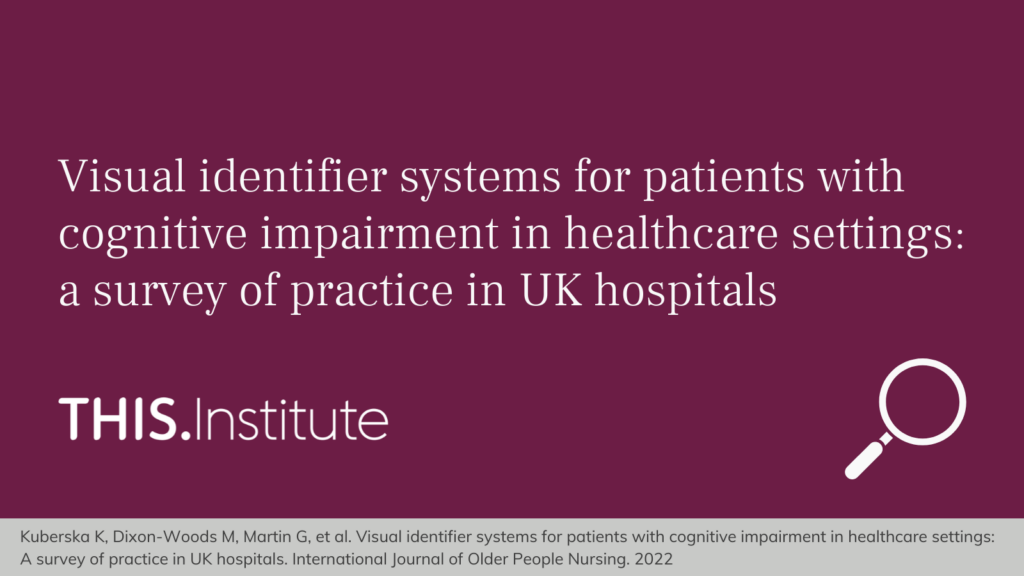Visual identifier systems for patients with cognitive impairment in healthcare settings: a survey of practice in UK hospitals
Why it matters
A large proportion of hospital inpatients are affected by cognitive impairment, including dementia and delirium. It is important that the needs of these patients are met, for example in relation to nutrition, hydration, toilet use, and understanding and consenting to treatment. However, it is not always straightforward for healthcare staff to recognise which patients have cognitive impairment.
One improvement approach taken by many hospitals is the use of visual indicators or identifiers to help staff quickly recognise patients with possible cognitive impairment. The aim is for these indicators to remind staff that the patient may have additional needs, which may be unrelated to the reason they are in hospital.
There are various systems used in hospitals in the UK, including: stickers placed near the patient’s bed or on their notes; a differently-coloured wristband worn by the patient; electronic whiteboards and similar technologies away from the patient; and summary information kept at the patient’s bedside. However, these systems have not been fully evaluated and the variation in approach to identifying patients with cognitive impairment may be introducing its own risks, for example when staff and patients move between hospitals.
Approach
Our study involved a survey to map current use of identification systems for patients with confirmed or suspected dementia in the NHS, and to obtain views from healthcare staff on the strengths and weaknesses of these systems.
We carried out an online survey of staff providing care for people with dementia in acute and mental health hospitals across the UK. We asked questions about nine existing systems that we had identified as being in use nationally, and also invited respondents to provide details of other systems, including locally developed ones.
What we found
We received 162 responses from staff in at least 48 hospitals. Of these, 128 had direct experience of using visual identifier systems.
Respondents reported that multiple identification systems are in use, including systems with national scope and locally developed approaches. Most respondents reported that more than one system is in use in their hospital.
Although respondents had a broadly positive view of identifier systems, different types of systems were seen to have different strengths and weaknesses. Reponses were largely positive about the key functions of the identifier systems: they were seen as easy to notice, helpful to staff, of benefit to patient safety, and easy to use. Risks were also highlighted, including lack of reliable and consistent use (linked to competing pressures on staff time), gaps in staff training, uncertainty about patient and family views, and unclear consent processes.
Our study provides some of the first insight into how identification systems are being used, and has highlighted that there is a wide range of systems in use in UK hospitals.
Results of our survey indicate that use of multiple systems may cause some challenges for staff, and it may be beneficial to consider their interoperability, alongside research into the advantages and disadvantages of standardisation of identification systems.
It is important that different perspectives – including those of patients and carers – are drawn upon when optimising the design of these systems. Further consideration should also be given to resolving ethical issues and supporting the implementation of systems. The wider visual identification programme being conducted in collaboration with the universities of Leicester and Aberdeen, the PHG Foundation, the Point of Care Foundation, and the Glasgow School of Art – addresses some of the issues in moving towards design principles for visual identifiers and their interactions with wider hospital systems.
With thanks to the DA VINCI contributor group:
Natalie Armstrong, Jackie Bridges, Tanya V. Brigden, Lesley Carter, Bev Fitzsimons, Joanna Goodrich, Alison E. Hall, Barbara Hodkinson, Chloë Hood, Louise Locock, Alastair S. Macdonald, Alasdair M. J. MacLullich, Colin Mitchell, Sean Ninan, Johan Ordish, Annabel Price, Allyson Rigby, Naomi S. Stockley, Carolyn Tarrant, Benjamin R. Underwood



